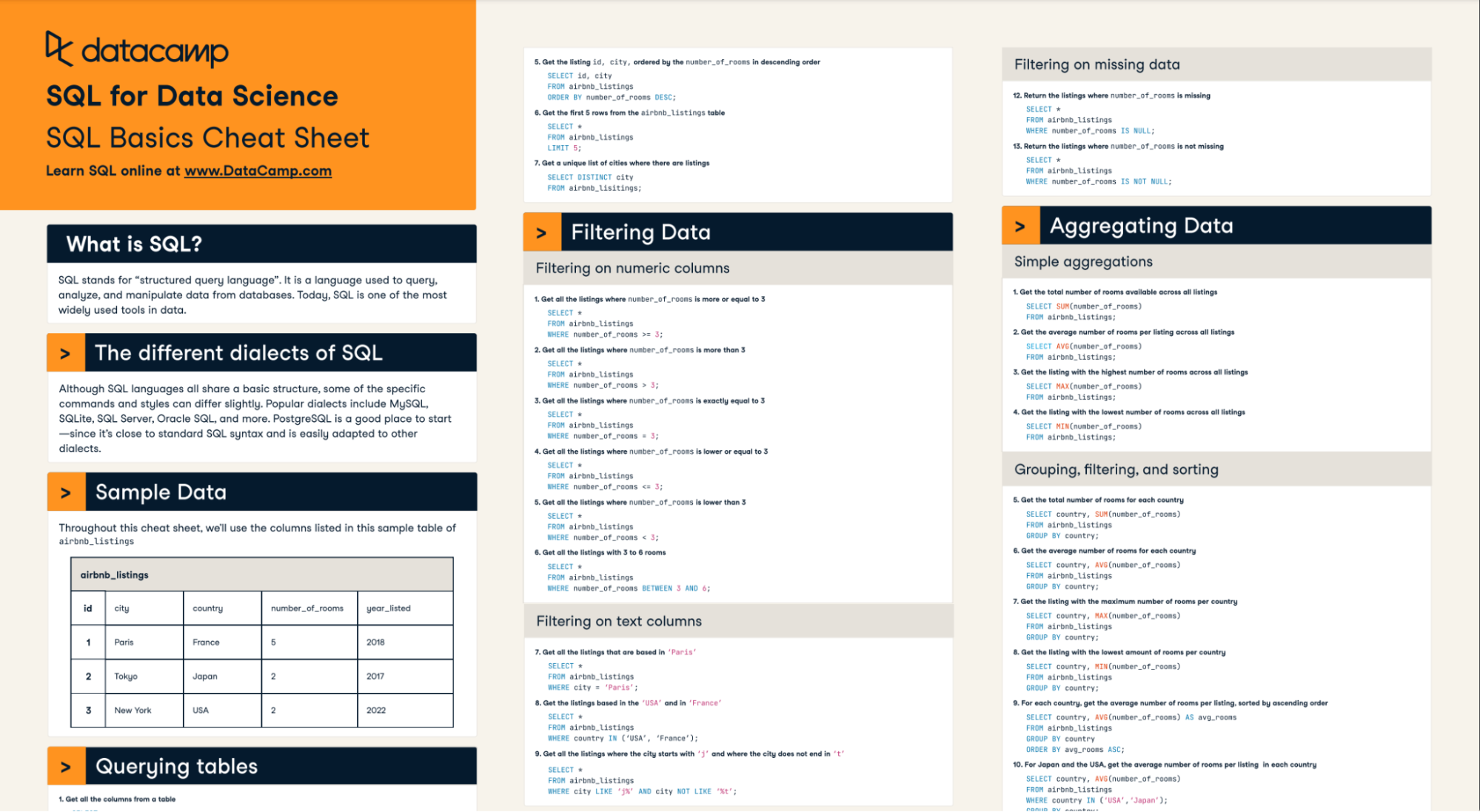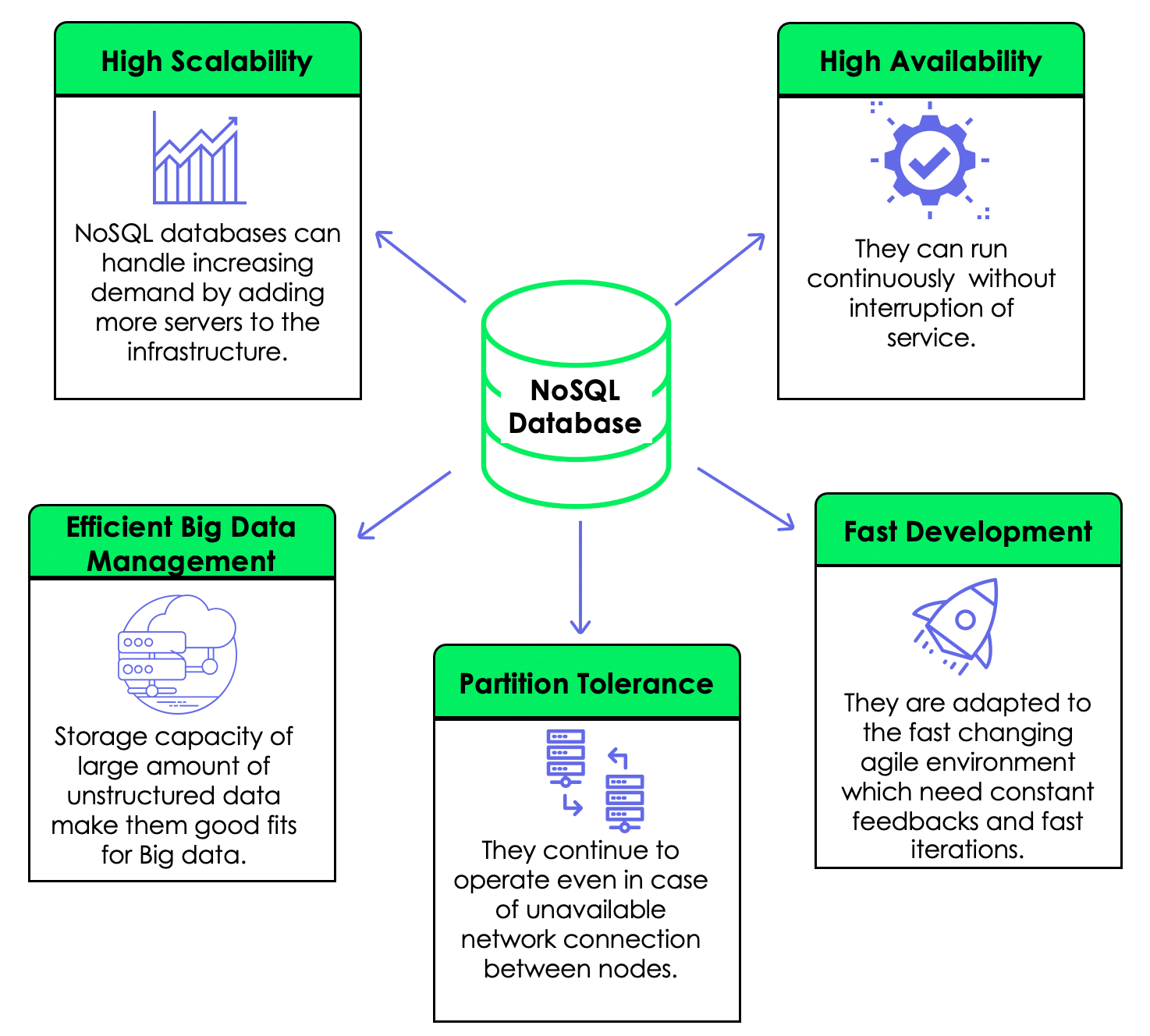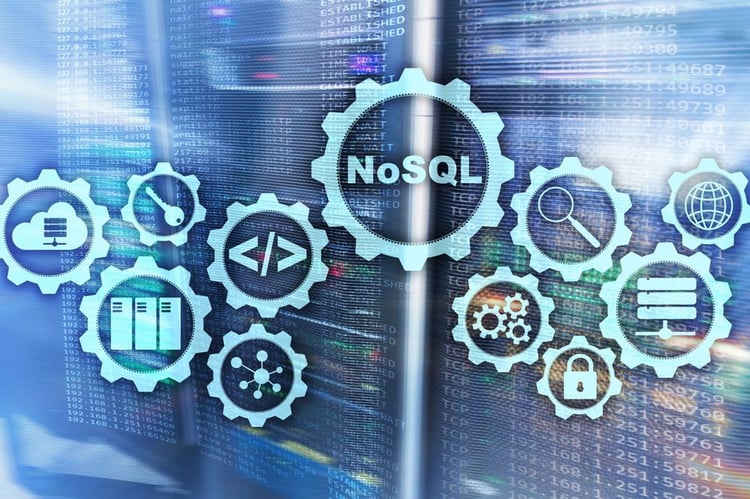Curso
A seleção do banco de dados é crucial na ciência de dados e no desenvolvimento de aplicativos, pois afeta diretamente o desempenho, a escalabilidade e a capacidade de lidar com os dados que estão sendo usados no aplicativo. A escolha entre NoSQL vs. NoSQL é uma questão de tempo. Os bancos de dados SQL afetam a eficiência da recuperação, do armazenamento e do processamento de dados, o que é fundamental para o sucesso e a capacidade de resposta dos aplicativos orientados por dados para atender a necessidades específicas.
SQL e NoSQL são duas tecnologias de banco de dados diferentes, com os bancos de dados SQL enfatizando modelos relacionais estruturados e os bancos de dados NoSQL adotando uma abordagem flexível e sem esquema para lidar com dados diversos e dinâmicos, com mais ênfase na escalabilidade e na velocidade.
Este artigo discutirá as diferenças entre os dois sistemas de banco de dados. No entanto, não abordaremos os fundamentos de nenhum deles. Confira nosso caminho de aprendizagem SQL Fundamentals para saber como acessar dados de bancos de dados SQL.
O que é SQL?
A gênese dos bancos de dados SQL
Em 1970, o modelo relacional para bancos de dados, um modelo para organizar e armazenar dados de forma eficaz em tabelas em uma estrutura de colunas e linhas, foi delineado pelo Dr. G. G., um dos maiores especialistas em bancos de dados do mundo. Edgar Codd em seu artigo de referência, "A Relational Model of Data for Large Shared Data Banks" (Um modelo relacional de dados para grandes bancos de dados compartilhados). Em 1974, a IBM desenvolveu o System R, o primeiro projeto a implementar o modelo relacional para armazenamento de dados, e desenvolveu o SQL como a linguagem para interagir com esses bancos de dados relacionais.
Ao longo dos anos, novos padrões para SQL foram desenvolvidos, e a Oracle, a IBM e a Microsoft desenvolveram sistemas de gerenciamento de bancos de dados relacionais (RDBMS) para usar o SQL de forma eficiente, segura e conveniente para interagir com bancos de dados SQL.
Em seguida, linguagens de código aberto, como o MySQL, começaram a tornar o SQL e os bancos de dados relacionais mais acessíveis à população em geral. O SQL agora é amplamente acessível em sistemas físicos e em nuvem, como AWS, Azure e Google Cloud.
Características dos bancos de dados SQL
Nos bancos de dados SQL, o modelo relacional serve como base conceitual, organizando os dados em tabelas estruturadas e interconectadas. Os bancos de dados SQL são compostos de esquemas e tabelas:
- Esquema: define a estrutura do banco de dados, incluindo tabelas, seus campos, tipos de dados, valores disponíveis e relacionamentos.
- Tabelas: As unidades fundamentais de um banco de dados, representando entidades (por exemplo, informações sobre clientes, produtos ou transações), com linhas contendo registros individuais para cada entidade (por exemplo, um cliente específico) e colunas armazenando atributos específicos sobre a entidade (por exemplo, o nome ou o e-mail do cliente).
O modelo relacional reforça a consistência por meio de dois tipos de chaves: (1) chaves primárias que identificam exclusivamente cada registro e (2) chaves estrangeiras que estabelecem relacionamentos entre tabelas. Você pode saber mais sobre bancos de dados relacionais em nosso curso Introdução ao SQL.
A SQL, ou Structured Query Language (Linguagem de Consulta Estruturada), serve como interface para gerenciar esses bancos de dados, permitindo a criação, recuperação, atualização e exclusão de dados por meio de comandos padronizados. Você pode ver uma lista desses comandos e dos recursos do SQL em nossa Folha de dicas básicas do SQL. Esse modelo e seus componentes oferecem uma estrutura avançada e flexível para organizar e consultar dados de forma a garantir a integridade e a coerência em todo o banco de dados.

Você pode dar uma olhada em nossa Folha de consulta de noções básicas de SQL
Vantagens do SQL
O SQL fornece um conjunto padrão de comandos para definir, consultar, atualizar e administrar dados em um sistema de gerenciamento de banco de dados relacional (RDBMS). As principais operações SQL incluem SELECT (consulta de dados), INSERT (adição de novos registros), UPDATE (modificação de registros existentes) e DELETE (remoção de registros).
Ao usar esses comandos, o SQL garante que as propriedades ACID (Atomicidade, Consistência, Isolamento e Durabilidade) sejam mantidas. Isso garante a confiabilidade e a consistência das alterações no banco de dados.
- Atomicidade: Essa propriedade garante que cada tentativa de conjunto de alterações em um banco de dados seja tratada como uma unidade de trabalho única e indivisível. Ou a unidade inteira é confirmada no banco de dados ou nenhuma delas é confirmada se alguma parte da transação falhar.
- Consistência: Garante que uma transação termine com o banco de dados em um estado válido. O banco de dados deve atender a um conjunto de restrições de integridade antes e depois da transação.
- Isolamento: Garante que transações simultâneas não causem inconsistências no banco de dados. Cada transação parece ser executada de forma isolada, sem saber que outras transações estão sendo executadas. O isolamento evita a interferência entre as transações e mantém sua integridade.
- Durabilidade: A durabilidade garante que, depois que uma transação é confirmada, seus efeitos persistem mesmo em caso de falha do sistema. As alterações feitas pela transação são permanentemente armazenadas no banco de dados e sobrevivem a falhas no sistema ou quedas de energia.
Essas propriedades fundamentais dos bancos de dados SQL garantem que os sistemas de banco de dados sejam confiáveis e consistentes, mesmo no caso de eventos inesperados ou falhas no sistema.
Sistemas de banco de dados SQL comuns
Há três RDBMS comumente usados:
- MySQL: O MySQL é um RDBMS de código aberto, agora de propriedade da Oracle, conhecido por sua velocidade, confiabilidade e facilidade de uso. O MySQL é frequentemente usado em ambientes da pilha LAMP (Linux, Apache, MySQL, PHP/Python/Perl) para aplicativos da Web de pequeno e médio porte.
- PostgreSQL: Um sistema de banco de dados objeto-relacional de código aberto com recursos avançados (por exemplo, suporte para funções e procedimentos personalizados, bem como para consultas complexas, indexação e transações). O PostgreSQL é melhor para aplicativos de grande escala, armazenamento de dados e dados geoespaciais.
- Microsoft SQL Server: Um RDBMS proprietário da Microsoft, que faz parte de um pacote com edições como Express, Standard e Enterprise. O Microsoft SQL Server se integra bem ao ecossistema da Microsoft e é adequado para diversos aplicativos, desde pequenas empresas até grandes corporações.
Confira nosso tutorial MySQL em Python para saber mais sobre como começar a usar esse RDBMS, bem como nosso Guia para iniciantes no PostgreSQL.
O que é NoSQL
Você pode ler nosso guia completo sobre O que é NoSQL para obter uma compreensão aprofundada dos bancos de dados Not Only SQL. Abaixo, resumimos nossas descobertas.
A ascensão dos bancos de dados NoSQL
Os bancos de dados NoSQL(Not Only SQL) foram criados como uma resposta aos desafios impostos pela expansão do big data e pela necessidade crescente de escalabilidade nos sistemas de banco de dados. Os bancos de dados relacionais tradicionais têm dificuldade para gerenciar com eficiência grandes quantidades de dados não estruturados e semiestruturados, comumente vistos no big data moderno. Os bancos de dados NoSQL representam uma alternativa mais flexível e dimensionável aos bancos de dados relacionais.
Eles lidam efetivamente com diversos tipos de dados, acomodam o rápido crescimento dos dados e distribuem os dados entre vários servidores com eficiência.
As soluções NoSQL, como MongoDB, Cassandra e Couchbase, não usam as mesmas estruturas rígidas que o modelo relacional suporta. Esses sistemas favorecem a flexibilidade do esquema e o dimensionamento horizontal, permitindo que as organizações se adaptem à natureza dinâmica do big data e, ao mesmo tempo, mantenham o desempenho e a confiabilidade. A correlação entre NoSQL, big data e escalabilidade ressalta uma evolução fundamental no gerenciamento de bancos de dados, capacitando as empresas a enfrentar os desafios apresentados pelo recente crescimento exponencial dos dados.
Características dos bancos de dados NoSQL
Ao contrário dos bancos de dados SQL, os bancos de dados NoSQL usam esquemas dinâmicos e suportam vários modelos de dados para atender às diversas necessidades dos aplicativos.
Uma característica que define os bancos de dados não relacionais é o uso de esquemas dinâmicos. Ao contrário dos esquemas fixos e predefinidos dos bancos de dados relacionais, os bancos de dados não relacionais permitem flexibilidade. Registros diferentes no mesmo banco de dados podem ter campos diferentes. Por exemplo, em um banco de dados de clientes, um cliente pode ter um campo de nome e idade, enquanto o outro tem um campo de nome e e-mail.
Há vários tipos de bancos de dados NoSQL:
- Armazenamento de documentos: Utilize uma estrutura flexível, semelhante a JSON, para armazenar dados como documentos. Eles são úteis para lidar com dados complexos e hierárquicos e oferecem suporte a esquemas dinâmicos. Eles são mais comumente usados em sistemas de gerenciamento de conteúdo, plataformas de comércio eletrônico e aplicativos em tempo real. Um exemplo popular desse sistema é o MongoDB.
- Banco de dados de valores-chave: Essa é a forma mais simples de banco de dados NoSQL, em que cada unidade de dados é armazenada como um par chave-valor. Esses sistemas são eficientes e úteis em cenários em que muitos dados precisam ser acessados rapidamente com tempos de resposta rápidos. Dois exemplos populares de bancos de dados NoSQL de valor-chave são o Redis e o Amazon DynamoDB.
- Banco de dados de gráficos: Esses bancos de dados representam relacionamentos entre entidades de dados. Portanto, eles são mais úteis em cenários em que os relacionamentos são importantes, como em redes sociais ou sistemas de recomendação. Dois exemplos populares de bancos de dados gráficos são o Neo4j e o Amazon Neptune.
- Banco de dados de família de colunas: Os bancos de dados da família Column representam dados em colunas em vez de linhas. Eles são melhores para sistemas distribuídos em grande escala e sistemas que leem e gravam com frequência, como aplicativos de série temporal e aplicativos de IoT. Os bancos de dados da família de colunas comumente usados incluem o Apache Cassandra e o HBase.
Você pode saber mais sobre o MongoDB em nosso curso Introdução ao MongoDB em Python.
A decisão sobre qual deles usar depende do aplicativo para o qual você está usando um banco de dados NoSQL.
Vantagens do NoSQL
Os bancos de dados NoSQL oferecem várias vantagens, com pontos fortes notáveis em termos de escalabilidade, flexibilidade e desempenho ao lidar com dados não estruturados.
Os bancos de dados NoSQL oferecem escalabilidade na forma de escalabilidade horizontal e elasticidade. Eles são projetados para escalonar horizontalmente, permitindo que as organizações lidem com quantidades crescentes de dados adicionando mais servidores a um sistema distribuído. Isso os torna adequados para aplicativos com cargas de trabalho crescentes ou imprevisíveis.
Muitos bancos de dados NoSQL também oferecem sharding e balanceamento de carga automáticos, distribuindo os dados em vários nós para garantir a utilização eficiente dos recursos e um melhor desempenho. Esse recurso permite que os sistemas aumentem ou diminuam dinamicamente com base na demanda e é conhecido como elasticidade.
Eles também oferecem flexibilidade de esquema. Os bancos de dados NoSQL usam esquemas dinâmicos, o que permite flexibilidade na representação de dados. Isso significa que os campos de um registro podem variar entre diferentes documentos, acomodando as estruturas de dados diversas e em evolução comumente encontradas em aplicativos modernos.
Eles também têm bom desempenho em tipos de dados não estruturados e semiestruturados, como JSON e XML. Atualmente, os dados costumam ser imprevisíveis, especialmente quando gerados pelo usuário, e o NoSQL lida bem com o armazenamento desses dados.

As vantagens do NoSQL em nosso artigo
Sistemas de banco de dados NoSQL comuns
Alguns dos sistemas de banco de dados NoSQL mais comumente usados são:
- MongoDB: popular banco de dados NoSQL orientado a documentos que armazena dados em documentos BSON flexíveis, semelhantes a JSON, oferecendo escalabilidade e alto desempenho para diversos tipos de dados.
- Cassandra: Um banco de dados NoSQL distribuído e altamente dimensionável projetado para lidar com grandes quantidades de dados em vários servidores com uma arquitetura descentralizada, tornando-o adequado para aplicativos de alta velocidade e alto volume.
- Redis: Um armazenamento de estrutura de dados na memória conhecido por sua velocidade e versatilidade, que serve como mecanismo de cache, corretor de mensagens e armazenamento de valores-chave, com suporte para várias estruturas de dados, como strings, hashes e conjuntos.
Principais diferenças entre SQL e NoSQL
Vamos comparar SQL e NoSQL para que você entenda melhor onde os dois se sobrepõem e contrastam:
Estrutura de dados
Os bancos de dados SQL, caracterizados por modelos de dados estruturados, aplicam um esquema predefinido em que os dados devem se encaixar em tabelas com colunas e tipos de dados específicos. Essa estrutura rígida garante a consistência e funciona bem para aplicativos com requisitos de dados estáveis e previsíveis.
Em contrapartida, os bancos de dados NoSQL adotam modelos de dados flexíveis, permitindo o armazenamento de dados dinâmico e sem esquema. Essa flexibilidade permite que os desenvolvedores insiram dados sem um esquema predefinido. Os bancos de dados NoSQL são mais úteis em cenários em que as estruturas de dados podem ser indefinidas ou mudar com frequência.
Escalabilidade
Os servidores SQL e NoSQL enfatizam diferentes pontos fortes de dimensionamento devido a seus projetos. Os sistemas SQL normalmente dependem do dimensionamento vertical, que envolve o aprimoramento e a adição de recursos ao mesmo servidor para lidar com o aumento da carga. O dimensionamento horizontal, normalmente visto em sistemas NoSQL, é obtido com a adição de mais servidores ou nós a um sistema distribuído, o que ajuda a aumentar a capacidade.
Nos sistemas NoSQL, os nós se comunicam entre si e distribuem a carga, portanto, adicionar mais nós ajuda a aumentar a capacidade geral do sistema. Essa é uma solução mais escalonável e econômica para gerenciar um banco de dados em crescimento e um maior tráfego de banco de dados.
Flexibilidade do esquema
Os bancos de dados SQL usam esquemas predefinidos, impondo uma estrutura rígida para a organização de dados e exigindo que as tabelas sigam uma estrutura predefinida de linhas e colunas. Em contrapartida, os bancos de dados NoSQL adotam esquemas dinâmicos, oferecendo flexibilidade na representação de dados. Esses bancos de dados permitem a inserção de dados sem uma estrutura predefinida, possibilitando que os desenvolvedores adaptem os esquemas em tempo real.
Essa flexibilidade é particularmente vantajosa para lidar com tipos de dados diversos, em evolução e imprevisíveis. Assim, os bancos de dados NoSQL funcionam bem em cenários em que as estruturas de dados podem não ser totalmente conhecidas de antemão ou estão sujeitas a alterações frequentes, enquanto os bancos de dados SQL funcionam bem quando os dados são bem estruturados e previsíveis.
Integridade transacional
Os sistemas de gerenciamento de banco de dados SQL e NoSQL adotam abordagens diferentes para garantir a confiabilidade. O SQL se baseia nas propriedades ACID (Atomicidade, Consistência, Isolamento, Durabilidade), que, como discutimos acima, garantem consistência imediata e rigorosa no banco de dados. As consultas SQL garantem que todas ou nenhuma das alterações feitas durante uma transação sejam confirmadas no banco de dados e têm regras sobre como lidar com transações simultâneas e eventos inesperados.
Por outro lado, os bancos de dados NoSQL, que enfatizam a escalabilidade e as arquiteturas distribuídas, adotam o conceito de consistência eventual. A consistência eventual reconhece que, em um sistema distribuído, pode levar algum tempo para que todos os nós convirjam para um estado consistente após uma atualização. Embora os bancos de dados NoSQL sacrifiquem a consistência imediata em prol da escalabilidade e da tolerância a falhas, eles garantem que, com tempo suficiente, todas as réplicas dos dados acabarão convergindo para o mesmo estado.
Essa compensação permite que os sistemas NoSQL lidem com ambientes distribuídos e de grande escala, nos quais a consistência em tempo real pode ser difícil de ser obtida com eficiência.
Escolhendo entre SQL e NoSQL
Se você não tiver certeza de qual banco de dados usar, descrevemos algumas maneiras de escolher entre NoSQL e SQL:
Cenários de casos de uso
Os bancos de dados SQL funcionam melhor em cenários em que os dados são estruturados e previsíveis, os relacionamentos complexos precisam ser capturados com precisão e a integridade imediata dos dados é importante.
As estruturas rígidas e as propriedades ACID do SQL o tornam adequado para esses tipos de aplicativos.
Alguns casos de uso comuns em que os bancos de dados SQL funcionam bem são:
- Aplicativos financeiros em que a consistência rigorosa é muito importante, e os dados são normalmente bem estruturados e representáveis em forma de tabela
- Os sistemas de gerenciamento de relacionamento com o cliente (CRM), nos quais os dados são normalmente bem estruturados, e pode haver muitos relacionamentos que precisam ser representados com precisão.
Os bancos de dados NoSQL funcionam melhor nos casos em que é útil ter estruturas de dados flexíveis que possam se adaptar dinamicamente a novas informações e esquemas, quando a escalabilidade e o desempenho são importantes e para dados não estruturados. Os esquemas dinâmicos e o dimensionamento horizontal do NoSQL o tornam excelente para esses tipos de casos de uso, que se apresentam em cenários como:
- Análise de big data em tempo real em que o desempenho rápido e dimensionável é importante
- Bancos de dados de mídia social em que grande parte dos dados recebidos não é estruturada e é imprevisível.
SQL vs. NoSQL no setor
Usos do banco de dados SQL
Alguns exemplos de setores que dependem de bancos de dados SQL são:
- Finanças: Muitas instituições financeiras gerenciam dados transacionais e registros de clientes. As propriedades ACID do SQL garantem que os dados sejam precisos e que as transações levem a um banco de dados imediatamente consistente depois de processadas.
- Varejo: Muitas empresas de varejo utilizam bancos de dados SQL, pois precisam gerenciar relacionamentos complexos relacionados a produtos, remessas, vendas, clientes e informações de fornecedores. Seus dados também costumam ser bem estruturados e previsíveis.
- Governo e setor público: Os órgãos governamentais gerenciam muitos registros de cidadãos e serviços públicos que estão sujeitos a requisitos regulamentares. A natureza estruturada do SQL ajuda na adesão às normas.
Usos do banco de dados NoSQL
Alguns exemplos de setores que dependem de bancos de dados NoSQL são:
- Mídia social: As plataformas de mídia social lidam com grandes volumes de dados não estruturados, como perfis de usuários, publicações e interações. A flexibilidade do NoSQL acomoda a natureza dinâmica do conteúdo e dos dados de mídia social.
- Logística e cadeia de suprimentos: Eles usam bancos de dados NoSQL para rastreamento em tempo real de remessas, gerenciamento de estoque e outras fontes de dados diversas e dinâmicas em toda a cadeia de suprimentos. O desempenho e a escalabilidade do NoSQL para dados em tempo real o tornam adequado para esse setor.
- Jogos: O setor de jogos utiliza bancos de dados NoSQL para gerenciar dados de jogadores, tabelas de classificação e análises de jogos. A capacidade de escalonar horizontalmente é essencial para lidar com as enormes quantidades de dados gerados por jogos multijogador on-line.
Conclusão
A escolha entre bancos de dados SQL e NoSQL desempenha um papel fundamental na eficácia e no sucesso da ciência de dados e do desenvolvimento de aplicativos. O impacto sobre o desempenho, o dimensionamento e a adaptabilidade aos tipos de dados influencia diretamente a capacidade de resposta dos aplicativos orientados por dados.
O SQL, com seu modelo relacional estruturado, é excelente em cenários em que os dados são bem definidos e as relações são cruciais, garantindo consistência imediata por meio das propriedades ACID.
Por outro lado, os bancos de dados NoSQL oferecem flexibilidade e escalabilidade, atendendo aos tipos de dados dinâmicos e não estruturados predominantes nos aplicativos modernos.
À medida que os setores evoluem, compreender as nuances entre essas tecnologias fundamentais de banco de dados torna-se essencial para arquitetos e desenvolvedores que navegam no cenário diversificado do gerenciamento de dados.
Se você quiser saber mais sobre a linguagem subjacente para acessar dados em bancos de dados relacionais, confira nosso curso de SQL intermediário.
Blogueiro de ciência de dados | Analista técnico na WayFair | MSE em ciência de dados na UPenn

